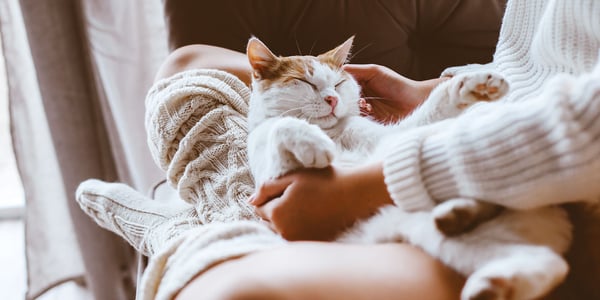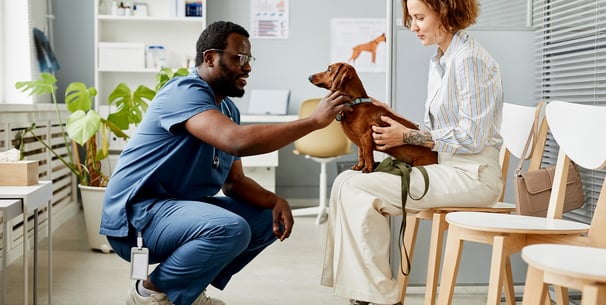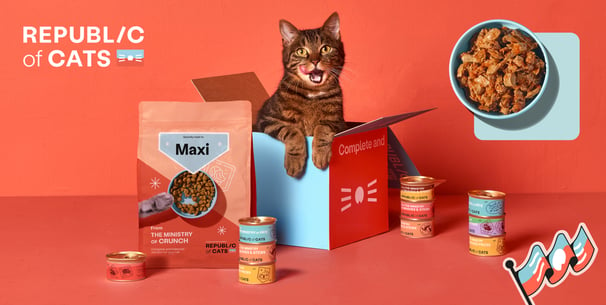Cat Sleeping Positions - What They Say About Your Cat
Index:



Introduction
When it comes to cats, every curl, stretch, and perch holds a secret meaning. So it's understandable that cat sleeping positions are more than just adorable poses; they're like windows into your cat's inner world. Understanding these postures can unveil a wealth of information about their comfort, mood, and overall well-being.
Join us on a journey to unravel the mysteries behind your cat's favourite nap-time poses and discover how this knowledge can lead to a deeper connection with your furry friend.
Why do cats sleep so much?
Because cats are natural predators, their hunting instincts require them to conserve energy for when they need to be active. Sleeping a lot helps your cat rest and recover from any physical stress, allowing them to have plenty of energy for when they need it. Cats typically sleep for about 12 to 16 hours per day, which you might notice if your cat is sleeping more or less than usual.
Beyond instinct, sleep plays a vital role in a cat's physical and mental well-being. It allows for tissue repair, memory consolidation, and metabolic regulation. Post-meal napping aids in digestion, ensuring they extract the maximum nutrients from their food. Finding a secure spot to rest also aligns with their survival instincts, offering protection from potential threats.
Whether it's to reduce stress, adapt to age-related changes, or simply enjoy sleeping, understanding a cat’s affinity for sleep unveils their innate behaviours and promotes a more harmonious relationship between you both.
Understanding your cat's sleep patterns is just one aspect of their overall development. If you're curious about your cat's growth journey, learn more about when cats stop growing here.
Common cat sleeping positions and what they mean
Cats can get themselves into some strange positions when sleeping, and as a cat owner yourself, you're probably already familiar with them. But do you know what they mean? Fear not, we're here to take a deep dive into the meaning of all different kinds of snoozing positions.
Some common sleeping positions:
Curled up in a ball



When a cat curls up tightly, it's a sign that your cat is comfortable and secure. This position helps them conserve body heat and protect their vital organs, reflecting a sense of contentment.
Sleeping on their back:



This position, also known as 'belly up,' indicates a high level of trust and comfort with their surroundings. It's a vulnerable position, as it exposes their belly, so a cat will only assume it when they feel completely safe.
Side sleeping:



Also known as the sideways cat sleeping position, this is a balanced position between relaxation and alertness. It shows that a cat is comfortable enough to fully relax but still aware of their environment and ready to respond if necessary.
In a loaf shape:



Also known as the cat loaf, this is a semi-relaxed position where a cat tucks its paws and tail beneath its body. It indicates a state of comfort and contentment, though the cat is still somewhat alert.
The Superman pose:



This is a playful position where a cat stretches out their front and back legs. It's often seen in kittens or very relaxed, comfortable adult cats.
Sleeping on furniture:



Cats choose elevated spots for a sense of security and to observe their surroundings. It's an indication that they feel safe and in control.
Strange positions:



Cats can adopt various odd and contorted sleeping positions. These can range from being folded in half to sleeping with their head at an unusual angle. While they may seem unconventional to us, they're typically a sign of relaxation and comfort.
Sitting upright:



While not technically a sleeping position, a cat sitting upright with eyes closed may be in a light doze or cat nap. This position allows them to quickly spring into action if needed.
On your body, head, feet, or between your legs:



If a cat chooses to sleep on or near you, it's a sign of affection and trust. They're seeking your warmth and comfort, and it's a strong indication that they feel safe in your presence.
Special cases: when sleeping positions could indicate health issues
In a box:



A cat sleeping in a box is not typically a health concern on its own. In fact, many cats find comfort and security in enclosed spaces like boxes. It's a natural behaviour for them and often indicates a sense of safety and relaxation.
However, if your cat begins sleeping in its litter box, or if this behaviour is accompanied by other concerning signs such as loss of appetite, lethargy, changes in litter box habits, or signs of distress, it could potentially be indicative of an underlying health issue.
In a litter box:



If a cat is consistently sleeping in the litter box, it can be a cause for concern. This behaviour may signal discomfort or a medical issue, such as a urinary tract infection. It's important to monitor this behaviour and consult a veterinarian if it continues.
Eyes open or half open:



Cats can sleep with their eyes partially or fully open, which is known as ‘catnapping’. This is a sign of a light sleep phase. It's perfectly normal and often seen in cats who are dozing lightly while keeping an eye on their environment for any potential threats or opportunities. However, if a cat is frequently sleeping with their eyes open or half open, and it's accompanied by other concerning symptoms, it's best to consult a veterinarian to rule out any underlying health issues.
Seeking veterinary advice is free and instant for all Waggel members, who can access Joii - an online vet care provider available 24 hours a day, 7 days a week. Just head to your online account to find out more. Or join Waggel and get a free quote today.
Behavioural contexts: sleeping and pre-sleeping routines
Just like us, cats have to prepare to go to sleep. They do this in a few ways, the most notable two being by kneading and grooming.
Kneading is a gentle, rhythmic motion that cats perform with their paws, often against soft surfaces like blankets or laps. It's also widely known as 'making biscuits' or 'baking,' which is just too adorable in our opinion. Kneading is a behaviour rooted in kittenhood, where kittens knead their mother's belly to stimulate milk flow during nursing.
As cats grow into adulthood, this comforting action persists, offering them a sense of security and contentment. Through kneading, cats also mark their territory, as their paws have scent glands. This leaves a subtle signature, reinforcing their ownership of the space, especially crucial in their chosen sleeping area. Furthermore, kneading serves as a physical release, akin to stretching for humans, helping to alleviate muscle tension and promote relaxation.
Another key way of winding down for sleep is grooming. Cats are renowned for their meticulous grooming habits. However, this ritual isn't merely about hygiene; it's an integral aspect of a cat's social and emotional well-being. Regular grooming maintains a clean, comfortable coat, which is pivotal for temperature regulation, especially during periods of rest. When cats groom one another, it signifies trust and affection, reinforcing social bonds within a group. In multi-cat households, mutual grooming fosters a sense of camaraderie and belonging. Ultimately, grooming is a powerful stress reliever, allowing cats to prepare for rest.
Medical concerns that affect cat sleeping positions
As a cat owner, it's important to observe any changes in your cat's sleeping habits, as alterations in positions could be indicative of an underlying health issue. If your cat consistently exhibits unusual or uncomfortable sleeping positions, it's recommended to consult a veterinarian for a thorough examination and appropriate treatment.
Some medical concerns that can affect cat sleeping positions include:
Diabetes: Cats with diabetes may experience discomfort due to elevated blood sugar levels, leading to restlessness and difficulty finding a position which is comfortable while sleeping. Diabetes can also cause nerve damage, potentially affecting a cat's limb strength and influencing their preferred sleeping postures. If your cat begins to display sudden changes in their sleeping pattern, or your cat is extremely uncomfortable when trying to sleep, it could be a sign of such underlying conditions.
Increased thirst: Cats needing to drink water more frequently may wake up during the night to satisfy their thirst, leading to more interrupted cat naps. This consistent need for hydration might prompt cats to adjust their sleeping positions, especially if they sleep under the covers to stay warm and hydrated. Observing if your cat likes to sleep near water sources could also be a clue about their hydration needs.
Sneezing and respiratory issues: Respiratory problems, such as allergies, infections, or asthma, can significantly impact a cat's ability to breathe comfortably. Cats experiencing these issues might choose the cat loaf position to feel secure while maintaining an open airway. You may notice them trying to seek out positions where they are not sleeping on their chest or sleeping with their belly exposed to facilitate easier breathing. It's essential to note any reasons your cat might start sleeping in these positions when it is out of the ordinary. Call your vet if your cat begins to exhibit other symptoms such as reverse sneezing.
Conclusion
Cat sleeping positions offer valuable insights into your pet’s health and well-being. Understanding these postures can reveal comfort levels, potential discomfort or pain, and emotional states. For instance, curled-up positions indicate contentment, unusual positions might signal discomfort and the trust displayed in belly-up positions fosters stronger bonds.
If a cat's sleeping behaviour deviates from the norm, consulting a veterinarian is crucial. Sudden changes may signify underlying health issues that require prompt attention for the cat's overall well-being and comfort.
FAQs
What is your cat's sleeping position telling you?
A cat's sleeping position can convey their comfort level, trust in their environment, and overall well-being. For example, a cat curled in a ball may indicate contentment and a sense of security. The way your cat sleeps and the different positions they choose can be a sign that your cat is feeling a certain way.
What is the cat shrimp position?
The cat shrimp position refers to a relaxed posture where a cat lays on their side with their legs tucked underneath, resembling the shape of a shrimp. Some cats may sleep on their side often, showcasing this adorable position.
What is the cold sleeping position for cats?
The cold sleeping position for cats involves them curling up tightly to conserve body heat and stay warm, reflecting an instinctive response to cooler temperatures. It's one of the most common positions when the temperature drops.
What does it mean when a cat is in a Superman pose?
The Superman pose is a playful position where a cat stretches out its front and back legs, resembling a flying superhero. It's often seen in relaxed and comfortable cats, indicating that your cat feels safe and content.
What is the prayer position in cats?
The prayer position in cats involves them sitting upright with their front paws close together, resembling a posture of prayer. It's a relaxed cat position, indicating that the cat is more likely to be calm and content.
What is a frog position in cats?
The frog position in cats refers to when they lay on their belly with their back legs stretched out behind them, resembling a frog's posture. It's a comfortable and relaxed position, showcasing the various adorable sleeping positions a cat can have.
How do cats sleep when happy?
When happy, cats may assume a variety of positions, such as stretched out or curled up, depending on their individual comfort and security in their environment. Now that you have cat sleeping positions explained, you can better understand how your cat feels.
How do cats sleep when sick?
When sick, cats may alter their sleeping positions to find a posture that minimises discomfort or pain caused by an underlying medical issue. They may choose positions that help alleviate symptoms or provide relief. If you notice your cat sleeping in the same position frequently or in an uncomfortable way, it might be time to consult with a vet. Every cat is different, so it's crucial to pay attention to any sudden changes if you see your cat acting out of character.
Waggel Pet Insurance
Need more help? You're in luck if you're a Waggel Pet Insurance member. Along with our excellent coverage, we offer access to a 24/7 online vet to answer all your sticky questions, especially if you need grooming assistance.
Not a member? Why not get a quote now and cover your furry friend for a range of illnesses, all while enjoying our amazing perks and rewards.
Want more like this?
Get updates from us with helpful info, advice, answers to frequently asked questions and much more.
Index:
Related posts:
Get your quote
Along with our excellent coverage, we offer access to a 24/7 online vet to answer all your sticky questions.





